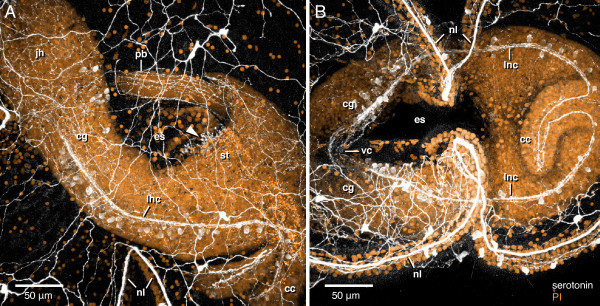Figure 11.
Serotonergic nervous system of the juvenile inside the pilidium of Micrura alaskensis. Confocal z-projections of the juvenile inside the pilidium larva at "complete proboscis" stage of development, stained with anti-5HT antibody (white) and propidium iodide (orange). A. Lateral view, juvenile head (jh) at upper left, juvenile caudal cirrus (cc) at bottom right. A fragment of the marginal ciliary nerve (nl) associated with the larval ciliated band is visible at the bottom center. Juvenile serotonergic nervous system includes paired lateral nerve cords (lnc) which originate from the cerebral ganglia (cg) and join in the caudal cirrus, subepidermal neurite network, longitudinal nerve fibers in the proboscis (pb), and the oral nerve (arrowhead) associated with the sphincter between the larval esophagus (es) and the stomach (st). B. Ventral view, juvenile head (jh) to the left, juvenile caudal cirrus (cc) to the right. Fragments of the marginal ciliary nerve (nl) associated with larval ciliated band are visible at the top and bottom. The juvenile lateral nerve cords (lnc) brightly labeled with anti-5HT antibody connect to the paired cerebral ganglia (cg), which are joined by a thick ventral brain commissure (vc). Lateral nerve cords join at the posterior end as they loop through the caudal cirrus (cc), thus forming a torus around the larval esophagus (es). See also additional files 6 and 7 -- Movie 6 and Movie 7.

